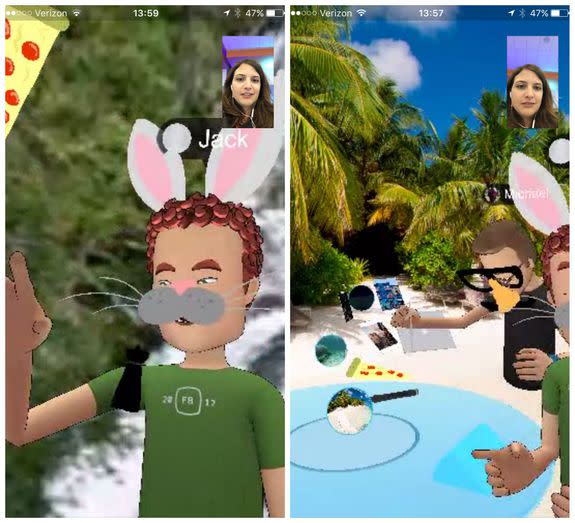Facebook's first social VR app is cool — but there's a problem

Facebook just took a big step forward in its bid to make virtual reality more social.
The company released Facebook Spaces at its F8 developer conference Tuesday, a new app for Oculus Rift that lets you hang out with friends in virtual reality. We took the app, which is available now in beta, for a spin. Here's what we learned.
It's limited — but that's the point
The "space" in Facebook Spaces is actually pretty simple. It consists of a table, a single menu and a screen that surrounds you. And that's about it. It's simpler even than Oculus Rooms, which have multiple destinations in a single space.
But that's intentional, says Facebook's Head of Social VR Rachel Franklin, who says the most important priority for now is to encourage interaction between friends.

Image: facebook
"It's important that we have kind of a north star for us, particularly in this early stage," she says. "If it's not enhancing social interaction between people who are Facebook friends then for right now leave it out."
That's also why Spaces is limited to up to four participants and why you can't move around too much once you're in a space. This will eventually change, she says, but only once enough people have used the app that they really know what types of experiences to build next.

Image: facebook
So what can you do in Facebook Spaces? You can draw with a virtual marker tool and move your drawings around. There are Clip Art-like objects that you can grab and play around with (or use as props for your selfies.) You can view 360-degree photos and videos, check out posts from Facebook friends and, yes, use the VR selfie stick.
It's both better than it sounds — technically, it's pretty impressive — and also as gimmicky as it sounds. VR selfies, like Snapchat filters, could easily lose their charm after a few tries.
About that avatar ...
Unsurprisingly, the first thing to do when you enter Facebook Spaces is create an avatar. While the avatars look similar to Oculus Avatars, Spaces doesn't pull from that separate platform.

Instead, you can choose one of your Facebook photos and Space generates a similar-looking avatar you can tweak yourself. To change something on your avatar you tap on the body part to choose from a list of options, like new eye shapes or hair colors. You can also add objects, like bunny ears or article of clothing.
You can hang out with friends who don't have VR
This is probably the most important feature in Facebook Spaces. Since the app is limited to people who have a Rift, Facebook allows friends to join these VR hangouts remotely via a Messenger call, which actually works a bit better than you might think.
Receiving a call is just like getting any other video call on Messenger but actually joining a video call in virtual reality is a bit different. You can see the virtual space your friends are in but you can't control your vantage point the way you could with a 360-degree video.

You can watch 360-degree videos with the people you're sharing a Space with, which is cool, but logistically a bit hard to manage.
This is all still in beta so the quality of the Messenger call isn't as sharp as the photos you take and share to Facebook, but even on convention center wi-fi I didn't notice any lag or other technical issues you'd expect from beta software.
I was pleasantly surprised that the whole experience was much better than expected after the hokey videos Facebook kept showing us. The bigger issue, though, is that the technology required to take advantage of this is too expensive and clunky for most people who aren't early adopters. That will likely change eventually, just not in the short term.
And whether this will evolve into something that's less of a gimmick and actually functional is unclear. After spending about half an hour each in the Spaces, both I and my colleague, tech correspondent Jack Morse, walked away impressed but unsure if what we saw would be something we would ever want to use on a regular basis.
Once the novelty of the experience wears off — and it's just a matter of time until it does — you're left wondering if strapping on an Oculus is worth all the extra effort compared with just picking up your phone.
